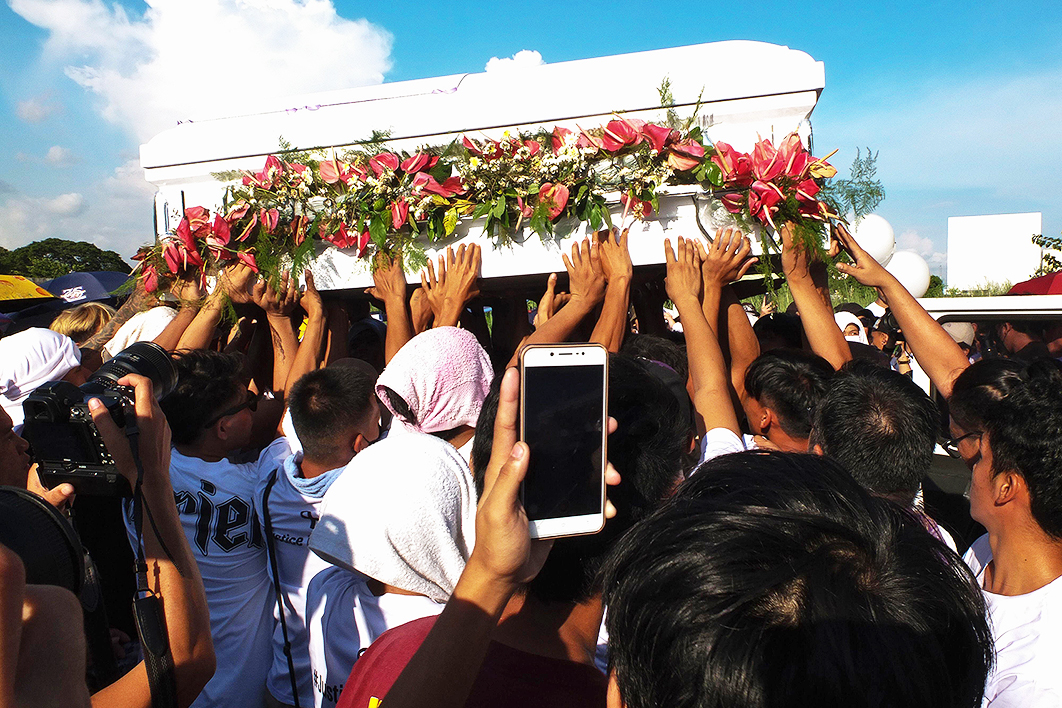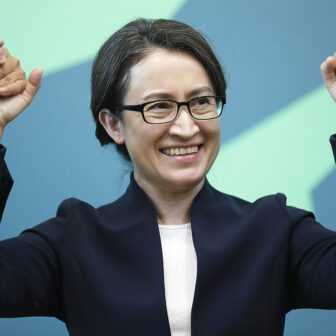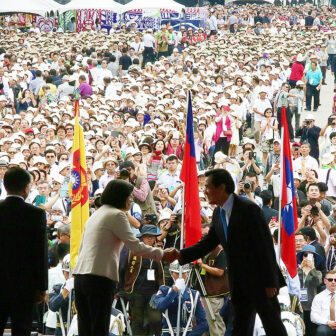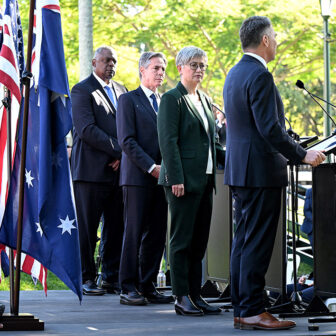Dangerous times make for uncomfortable bedfellows. When prime minister Anthony Albanese visited the Philippines in September it was the first bilateral visit by an Australian leader in twenty years. He signed a strategic partnership with president Ferdinand “Bongbong” Marcos — son of the country’s dictator from 1965 to 1986 — that includes more scholarships for students, expanded work and holiday visa rights, and a new Philippines Institute at the Australian National University.
The Australian media greeted the news warmly. Marcos’s predecessor, the uncouth Rodrigo Duterte, was rightly described as a serial human rights abuser, had shown signs of embracing China and distancing his country from the United States. Marcos, by contrast, was described by journalists as “suave” and “personable.” But most important of all, he is resisting Beijing’s expansionism in the South China Sea. And he backed AUKUS more enthusiastically than any other Southeast Asian leader.
As the ABC’s Tom Lowrey reported, “There has been a level of surprise among some in government ranks about the pace at which the Philippines has pivoted towards the West under the Marcos administration.” Albanese left Marcos with an invitation to visit Australia next March for a summit marking the fiftieth anniversary of ASEAN–Australian dialogue relations.
Meanwhile, away from governing circles in Manila, Vincent Go is thinking of becoming a chef. For the past seven years he has been one of a group of Filipino photojournalists trying to document deaths in the “war on drugs” that Duterte kicked off when he took the presidency in 2016.
At the height of that “war,” when dozens of corpses could be found on the streets every night, Go and his fellow “nightcrawlers” would follow the police from shooting to shooting. For a few months, with the extraordinary unleashing of state-sanctioned violence against the poor making world headlines, the nightcrawlers were accompanied by members of the world’s media. The official narrative was always the same: the accused fought back — sometimes despite being handcuffed — and were killed by police in self-defence.
On top of that were extrajudicial killings, or EJKs as they are known: the shootings by masked motorcycle-riding gunmen. In filings before the International Criminal Court, the Philippines authorities have acknowledged what everyone else has long understood — that these killings were probably also linked to the police.
Duterte has gone but the deaths continue. The difference, says Go, is that nobody cares anymore. The world’s attention has shifted, and Go’s fellow journalists can no longer be bothered reporting the stories. Go himself needs to earn a living, and he can’t sell his photos to a largely supine local media. So his Facebook page carries his photos of corpses and wakes, interspersed with videos of the dishes he is learning to cook.
Go and I met a fortnight ago in a tiny Quezon City cafe called Silingan, which was set up to provide jobs and support for the widows of the dead. Accompanied by his fellow nightcrawler, Raffy Lerma, the photojournalist had just come from another wake.
The killing being commemorated was the third in a series over the past two months. The first came on 2 August, when twenty police descended on a slum looking for an alleged murder suspect. Spotting two young men preparing to set out on a fishing boat, they opened fire, killing seventeen-year-old Jerhode “Jemboy” Baltazar. It was a case of mistaken identity, though they didn’t stop to check.
Unusually — because many witnesses contradicted the police version of events and because Baltazar was clearly entirely innocent — the media covered the outrage. Baltazar’s family have filed murder charges against all but one of the police officers involved in his killing. At hearings on the killing, the Philippines Senate has held several officers in contempt for evasive and inconsistent evidence. But nobody I asked is hopeful of a meaningful result.
A month after Baltazar’s death, two of his friends arrived at a 7-Eleven store expecting to meet an acquaintance. It was a set up: they were shot by masked gunmen who had been waiting for them. One of them, Daniel Soria, was wounded but managed to flee into the maze of slum alleyways. As CCTV footage shows, he was on his knees in the middle of the street when the gunmen circled back and shot him dead. They took his phone and replied “Patay na asawa mo” (“Your husband is dead”) to a text message left by his girlfriend.
Baltazar’s other friend, John Rey Basie, also wounded in the 7-Eleven attack, knew he was likely to be next to die. Sure enough, his body was found on a bridge in Navotas City at dawn on 6 October. He had been shot in the back of the head. It was his wake that Go and Lerma had just attended.
After our meeting, Go posted pictures of the wake on his Facebook page. “Three friends from the same neighborhood, three friends who played basketball together, three friends who shared joys and sorrows with what little they had, and the gruesome death of three friends who was killed one after the other,” he wrote. “Have we become too frightened to be labelled as enemy of the state or have we become too callous that we could not even demand answers and accountability from those who have been elected or appointed to keep peace and justice?”
In any Western country, deaths like these would cause demonstrations, even riots, and assertions of the obvious — that these lives matter. In the Philippines, those who care are too frightened to speak. And the West has other reasons to ignore the violence and the human rights abuses it represents.
The Philippines archipelago cradles the eastern edge of the South China Sea. Colonised by Spain in 1565, taken over by the Americans in 1902 and briefly captured by Japan during the second world war, its strategic location is again bringing it superpower attention.
The archipelago is home to a series of American military bases, including the well-known naval installation at Subic Bay. But Duterte made a point of flirting with Beijing. Just before he came to power, the international courts had found in the Philippines’ favour in a dispute over islands also claimed by China. As president, he proved tolerant of Beijing’s ambitions.
If the Philippines had fallen into China’s sphere of influence, the world’s balance of power would have tilted. And so the West was happy to consign Duterte to history as a human rights abuser and welcome his successor.
Marcos Junior came to power promising a more humane approach to the country’s undoubted drug problem. In a news release to mark his first hundred days in office he claimed the war on drugs was now “less bloody, more holistic.”
It’s true that the number of killings is lower than the peak in 2016–17. But the best available figures, compiled by the Dahas project of the Third World Studies Center at the University of the Philippines, show that deaths, far from easing under Marcos, are more common than in the last years of the Duterte administration. (Dahas acknowledges that its figures are underestimates; they are drawn entirely from the media, which doesn’t report many fatalities.)
The project recorded 150 killings by state agents in Duterte’s last year, twenty-seven by non-state agents, ninety-eight where the identity of the killer was not known, and twenty-seven “body dumps” — a total of 302-drug related killings. But in the fifteen-and-a-half months of Marcos’s presidency up to 15 October this year, state agents have killed 195 people, with fifty-six killings by non-state agents, 143 by unknown killers and forty-four body dumps: a total of 438. In other words, more people have been killed under Marcos than under Duterte in his last years.
Unlike some of its other cases, the International Criminal Court’s investigation of the Philippines’ war on drugs has attracted very little attention. In July this year the ICC rejected an attempt by the Philippines government to have the inquiry dropped; contrary to the Marcos government’s claims, it found no evidence of a credible domestic investigation of the killings. Marcos maintains he won’t cooperate with the court’s investigators.
In the two weeks I spent in the Philippines talking to victims and human rights groups, I found no one who had heard from the ICC since July’s decision. Whatever the investigators are doing, they are certainly not “on the ground.” When I requested an interview, the ICC responded that no one was available. In any case, it can only investigate the pre-2019 killings under Duterte because the Philippines withdrew from its jurisdiction that year.
Go says the ICC is believed to be drawing on media reports for evidence and talking to peak human rights bodies. But this is not the same as doing what he does and seeing what he sees — traversing the fetid slums, feeling in his pores the ever-present threat of violence and the helplessness of poverty, and interviewing the grieving families. The ICC’s dry, legalistic and protracted proceedings — the video footage might be recommended for insomniacs — could hardly be more of a contrast.
During my visit I was told of at least seven killings that weren’t reported by the media and therefore not included in the Dahas figures. I was shown a video circulating among victim-support groups that was taken last year by a terrified family member hiding in a darkened bedroom.
Harsh voices can be heard over the barking of dogs. The camera shakes. Four men encircle a man whimpering on the floor. According to his family, the men — police in civilian clothes — had been torturing the man and were forcing him to drink soapy water from the tubs of laundry in his home. The video shows them grabbing their victim under his armpits and dragging him out of the house and out of the camera’s view.
In the official police record of what happened that night, he had been arrested along with two others in a “buy bust” drug operation. There is nothing in the official record to indicate that he died.
But the day after the video was recorded, his body was found in a nearby street. Pictures taken by family members in the morgue show bruising to his face and chest, yet the death certificate records the cause of death as a heart attack. As a result this death was not reported by media, and doesn’t show up in the Dahas figures.
Now, family members don’t want to depart from that narrative or release the video, because they are frightened. People who make a fuss — like the family and friends of Jemboy Baltazar — know what to expect.
Deaths aren’t the only result of the “war.” I met a woman whose brother was charged with drug offences. He says he was a stand-in for the true guilty party, who had paid off police. He was eventually found not guilty and was released late last year. By then, he had spent ten years in jail, and his health was ruined.
More recently, a sixty-year-old British health worker, Elden Chamberlain, went public after spending two years in jail, with court hearings repeatedly delayed, on what he says are fabricated drugs charges. Chamberlain’s case is exceptional not only because he is a well-to-do foreign national but also because he has the resources to fight.
The Philippines jails are filling up with similar cases involving locals, many of whom can’t afford to contest the charges but make plea bargains in return for freedom. Bail is rarely granted in drug cases, which can take many years to come to court.
Late last month the World Justice Project released its annual index on the rule of law in 142 nations, based on national surveys of more than 149,000 households and 3400 legal practitioners. The Philippines had dropped three spots from its ninety-seventh ranking in 2022. In the East Asia and Pacific region, the Philippines is at thirteenth place out of fifteen nations.
What does the “suave” Marcos make of all this? Many things about the Philippines are opaque, but the best guess of the human rights activists I interviewed is that Marcos is not entirely in control of the police force. On top of an already violent law-enforcement culture, Duterte encouraged a culture of impunity. Marcos seems helpless to combat this.
Or perhaps he doesn’t want to. His vice-president, after all, is Sara Duterte, daughter of the former president.
Many Filipinos have voted with their feet. The country has one of the largest diasporas in the world, including 400,000 Australians of Filipino heritage — a figure Albanese cited when describing what the two countries have in common.
One of the 400,000, a nurse at a major capital city hospital, is the daughter of the man who was tortured in the video I saw, and later killed. She has communicated with me, but won’t go public. Her family is in Manila, and vulnerable. She’s one who won’t be celebrating Marcos’s visit in March.
Vincent Go, meanwhile, is perfecting his Chinese braised pork. •




